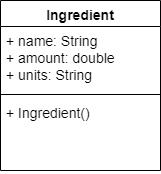Objects & Initialization
Of course, our classes are not very useful at this point because they don’t include any attributes or methods. Including instance attributes in an object class is one of the their basic uses, so let’s start there.
Types of Attributes
There are two types of attributes: Class and Instance.
Instance attributes are variables that “belong” to the instance. It makes sense that a Student object owns its own name.
We will defer discussion of class attributes to a later module.
Instance Attributes and the Constructor
To add instance attributes to a class, we can simply place a variable declarations with access modifiers inside the class but outside of any methods.
public class Ingredient{
public String name;
public double amount;
public String units;
}This tells the compiler that each instance of “Ingredient” will have three variables. This is one of the ways that objects store their data. It is possible to assign values at this point, i.e. public int amount= 2;, but this stylistically bad. Default values should be assigned in the constructors.
The Constructor
The Constructor is a method named after the class. It called each time an object is instantiated; it gets triggered by use of the new keyword. Typically the constructor sets default values for the instance attributes.
The Java compiler creates a default, no parameter constructor for every class.
public Ingredient(){} // provided by the complier if not overwrittenBut it is normal to override this definition with a constructor if your own.
public Ingredient(){
this.name = "flour";
this.amount = 2.0;
this.units = "cup";
}Typically, all instance variables should be given a value in the constructor. This gives programmers one place to look for all the names and values of all the instance variables in the object. Also, the constructor(s) should always be the first method(s) inside an object class’s definition.
this
Java uses this to refer to the specific object used when calling a method. It is the mechanism that ensures the Ingredient object first sees first’s data and Ingredient object second sees second’s data. It is typically used for clarity.
public Ingredient(String name, double amount, String units){
this.name = name;
this.amount = amount;
this.units = units;
}Here the parameter names obscure (or shadow) the instance variable names, and the use of this clarifies the code. We assign the values of the parameters to the instance attributes of the same name. “Shadowing” instance/class names with parameter names is considered bad coding style anywhere except in constructors. Even in constructors is is easy to avoid, such as using public Ingredient(String nameIn, int amountIn, String unitsIn).
Feel free to refer to the UML diagram below to find the correct instance attributes for the Ingredient class so far.
